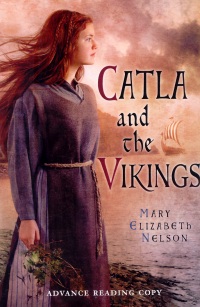| ________________
CM . . . . Volume XVIII Number 22 . . . . February 10, 2012
excerpt:
Thirteen-year-old Catla is a dreamer. Recently betrothed to the merchant Olav, she has wandered away from the village to consider her future. As she heads back, she witnesses the Viking raid on her village. Her family and neighbours are herded into the goat pens as prisoners. Unsure, but realizing she has to act, Catla decides to try to get help. On her journey to the neighbouring village of Aigber, she meets Sven, a boy from Covehithe, her village. The two of them rely on each other to complete their journey, both terrified of what may be happening at home. In Aigber, the villagers come up with a plan to save themselves and Covehithe. Nelson's novel takes place in the fall of 1066. King Harold of Norway has begun his raids on Northern England following the death of King Edward and the subsequent turmoil for leadership. Small Anglo-Saxon towns that had developed as good commerce and community centres were under attack by Viking ships that moved into the area set on raiding the villages. Nelson's novel depicts this time in history with descriptions of the people, the landscape, and the village life. Told with Catla's voice, the language also reflects a different time both in choice of words and the perspective of a young girl in this society. Catla struggles with her need to be obedient and her need to be herself. Her father and the steward to their lord, the Earl of Northumbria, are planning her future. She knows that it is expected that she marry Olav and move to York where he does business. She also knows that she can't stand Olav and loves her own village. While her journey to Aigber is primarily to find a way to save her family, Catla is confronted by other traditions and cultures that make her question her own experiences. In Aigber, the headman, Hugh, and his wife, Edith, treat each other as equals, while in her own home, her father is the undisputed leader. Nelson provides several examples within her novel of diversity of relationships and gender roles. This allows the reader to understand that this historical setting was often as complex and diverse as our own time and that adolescence is always a time of looking for answers. Nelson has created some characters that the reader can relate to because of their complexity and their flaws. While Catla may be a hero, she is far from brave and even less confident. The relationship between Sven and Catla is also complicated and does not end with a clear indication of what will happen in the future. While the reader hopes, of course, that Catla, Sven, and the villagers are able to save Covehithe, the resolution seems a little too easy. It is explained that these "nord-devils" are perhaps not the brightest of the bunch, but the way that the tables are quickly turned on them is a little too clean. Other storylines, such as the reformed Viking, Ragnar, and the impending invasion by the "real Vikings" suggest a sequel in the works. Nelson provides some historical information in her author's note, which is interesting and explains much of the context of the time setting. It is not necessary for enjoyment of the novel as a coming-of-age story with elements of action and survival. A good choice for readers with a variety of interests. Recommended. Karen Boyd is a doctoral candidate in language and literacy and an instructor in the Bachelor of Education program at the University of Manitoba.
To comment
on this title or this review, send mail to cm@umanitoba.ca.
Copyright © the Manitoba Library Association. Reproduction for personal
use is permitted only if this copyright notice is maintained. Any
other reproduction is prohibited without permission.
NEXT REVIEW |
TABLE OF CONTENTS FOR THIS ISSUE
- February 10, 2012.
AUTHORS |
TITLES |
MEDIA REVIEWS |
PROFILES |
BACK ISSUES |
SEARCH |
CMARCHIVE |
HOME |
